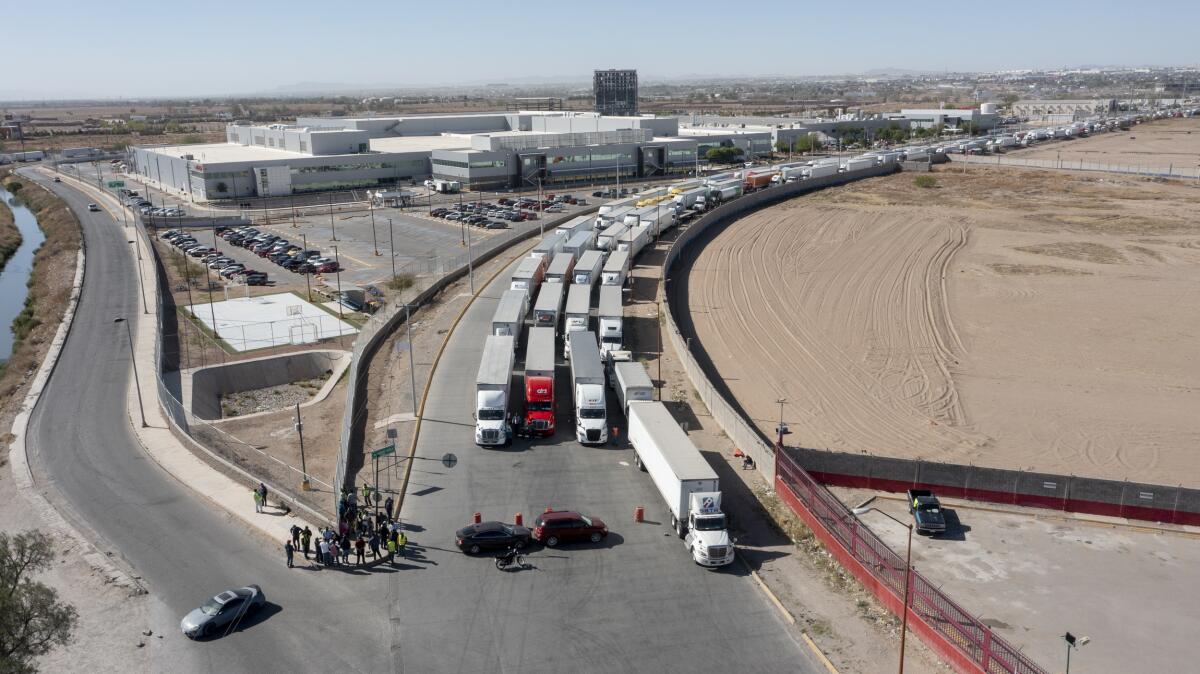Shift in China-U.S. trade is hurting California, helping Texas

WASHINGTON — As if it weren’t worrisome enough for California that more highly skilled, highly paid workers have been leaving for Texas, evidence shows that the Lone Star State has begun to siphon trade dollars and uncounted jobs away from the Southland’s ports and the distribution hubs in the Inland Empire.
And the apparent cause of the new wrinkle in the Texas-California rivalry is not some new policies or programs adopted in Texas to make it a greater magnet for economic activity that was previously in California. Instead, it’s a consequence of the U.S.-China trade war that began when Donald Trump occupied the White House and has continued with President Biden’s efforts to reduce American dependence on China, especially for high-tech products that involve national security and other issues.
To get around the U.S. tariffs and trade restrictions, Chinese companies have sharply stepped up investments into Mexico and been moving products into the United States by truck instead of shipping by sea through the massive port and distribution systems in Southern California.
The ports of Los Angeles and Long Beach are the busiest in the nation and handle about 40% of all ocean cargo from Asia. But last year the number of 20-foot-equivalent containers from China entering the San Pedro ports complex fell a combined 12.5% from 2022, to the lowest level in at least a decade, according to data from S&P Global Market Intelligence.
“If we’re doing less business, it means fewer jobs, quite simply,” said Gene Seroka, executive director of the Port of Los Angeles. He said that every four containers translate into one job. “Economically, where all of us spend our money, if we don’t have this cargo coming through, it will be less — and there will be choices to be made.”
China’s share of all containers entering the Port of L.A. still remains dominant, at 53% last year, although that’s down from 57% in 2022. Seroka sees that percentage slipping to the mid-40s in the coming years.
The Southland’s cargo volume, overall, has picked up significantly in recent months, thanks to the end of labor contract talks and diversions to the West Coast due to military conflict and drought disrupting the Suez and Panama canals, respectively.
But longer term, Seroka said a dwindling of Chinese inbound containers has to be made up elsewhere. In addition to some 15,000 longshoremen, the two ports support hundreds of thousands of jobs in the region — in trucking, warehousing, trade finances and countless small businesses.
California’s stringent environmental regulations and high business costs add to the pressure.
To be sure, increased Mexican imports also benefit Southern California, which historically has gotten a large volume of overland trade, particularly electronic products coming up the San Diego border. But the biggest entry point for Mexican goods is Laredo, Texas, just north of the big manufacturing center in Monterrey, Mexico, and then El Paso, close to Juarez.
“Since more and more goods are coming from Mexico, Texas is geographically and conveniently located,” said Sung Won Sohn, an economics professor at Loyola Marymount University.
Tom Fullerton, a border business economist at the University of Texas in El Paso, said a lot of things made in Mexico are intermediate components, many of which go back and forth across the border as many as a dozen times. Some 90% is transported by trucks. No wonder employment for truck drivers in Texas has been growing nonstop, while California’s has come to a screeching halt, according to the U.S. Bureau of Labor Statistics.
“Increased Chinese investment simply creates more business opportunities for firms in Texas,” Fullerton said.
At the moment, trade economies in both Texas and California face some head winds, including a slowing U.S. economy as a result of anti-inflation efforts, plus cutbacks by retailers and other buyers that overstocked merchandise even as American consumers have been shifting their spending from stuff to services, such as travel and entertainment.
“Now that we filled the house with everything, everything we could wear and use for years, they’re saying, ‘Let’s go to the movies, the ballgame,’” said Jock O’Connell, a California trade specialist at Beacon Economics. “U.S. demand for imported goods from anywhere is slacking.”
In a reversal from past decades, more college graduates and professionals are moving out of California than coming into it to escape the higher taxes and cost of living.
Last year U.S. imports of all merchandise from China, by ship and air, fell by a whopping 20% from 2022, to $427 billion. The Commerce Department reported Thursday that Chinese imports in January were up slightly from December, but down 6% from January 2023.
Meantime, U.S. imports from Mexico continued to rise in January and compared with a year earlier, extending the lead over China. Mexican imports jumped after the worst of the pandemic passed and reached $476 billion last year. It was the first time in more than two decades that Americans bought more merchandise from Mexico than China.
Overall, the U.S. trade deficit of all goods and services fell last year by almost 19%, the largest drop since 2009, as Americans bought less foreign oil and fewer China-made phones, toys and household goods. In January, the trade deficit increased, to $89 billion, as American exports were lower than December and year-earlier figures.
Efforts to diversify production away from China have been going on for years, in part as a hedge against political risks and rising labor and business costs in China. But the move to Mexico and some other nations gained speed after then-President Trump in 2018 slapped large tariffs on a wide array of Chinese imports.
President Biden hasn’t lifted them, and in some ways further tightened the trade screws on China. The pandemic added to the so-called reshoring or near-shoring momentum as multinationals, stung by a breakdown in transport and supply chains, sought to be closer to their markets.
Harry Moser, founder of the Reshoring Initiative to bring manufacturing back to the U.S., said the changes in trade volume by country don’t tell the full story. Although he called the drop in the American trade deficit with China last year a good thing, Moser questioned whether the U.S. is really less dependent on China.
What’s happening, he argued, is that there’s considerable rerouting of trade from China through Mexico. And he fears it could get worse, pointing to the Chinese firm BYD’s plans to build an electric vehicle factory in Mexico for export to the U.S. Even Tesla, which makes its cars in Shanghai as well as Texas, is apparently urging some of its Chinese suppliers to locate in Mexico, he said.
“It’s not time to celebrate the China news,” Moser said of the reported drop in Chinese imports to the U.S.
Apparently there’s no cause to celebrate in the Southland either.
Chinese automotive parts companies have been among the most aggressive in stepping up investments in Mexico. Thirty-three car parts suppliers of Chinese origin are now registered in Mexico, and 18 exported $1.1 billion worth of products to the U.S. last year, up 15% from 2022, said Michelle Sagrero, communications manager at INA, the auto parts industry association in Mexico. She said more Chinese investments are in the works, though she said it was too early to disclose how many companies.
Overall, Chinese foreign direct investment, while stalling in the U.S., has kept growing in Mexico and topped $2.5 billion in 2022, a fivefold increase from 2000-04, according to Red ALC-China, a nonpartisan network of academics in Mexico and other countries. The tally for Chinese investments in 2023 hasn’t been published yet, but “it’ll be substantially higher,” said Enrique Dussel Peters, coordinator for the Center for Chinese-Mexican Studies at UNAM, a university in Mexico City.
The U.S.-China trade war has undoubtedly played a big role, he said. In his study for a United Nations economic group, Dussel Peters found that in 2021, companies exporting goods from China to the U.S. paid 18.8% of the value of their shipment in tariffs and transportation costs. The comparable costs for Mexico-originated exports to the U.S. — 1.05%.
“The difference is substantial, to put it politely,” he said.
Dussel Peters said he expects more Chinese and other foreign companies to invest and set up shop in Mexico. Mexico has free trade pacts not only with the U.S. but also a few dozen other nations, and it has its own sizable domestic market too. But he noted that there is one potential hitch. Thus far, Washington hasn’t come down hard in pressuring Mexico to follow the U.S. on China trade and investments.
“There is always the threat that the U.S. becomes more serious about complying with U.S. regulations and restrictions,” Dussel Peters said. “You can’t continue with a trade war and profound conflict and have a major partner of the U.S. with a sign saying to the Chinese, ‘Welcome to Mexico.’”
More to Read
Inside the business of entertainment
The Wide Shot brings you news, analysis and insights on everything from streaming wars to production — and what it all means for the future.
You may occasionally receive promotional content from the Los Angeles Times.












